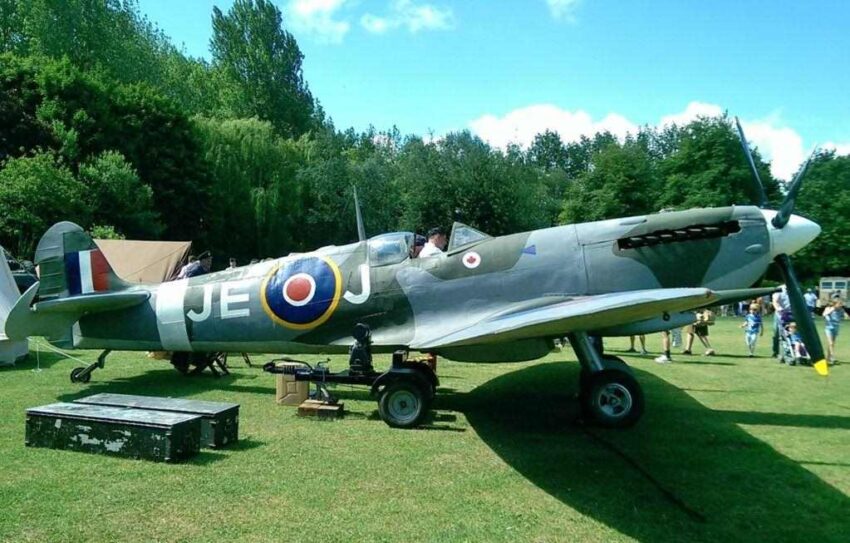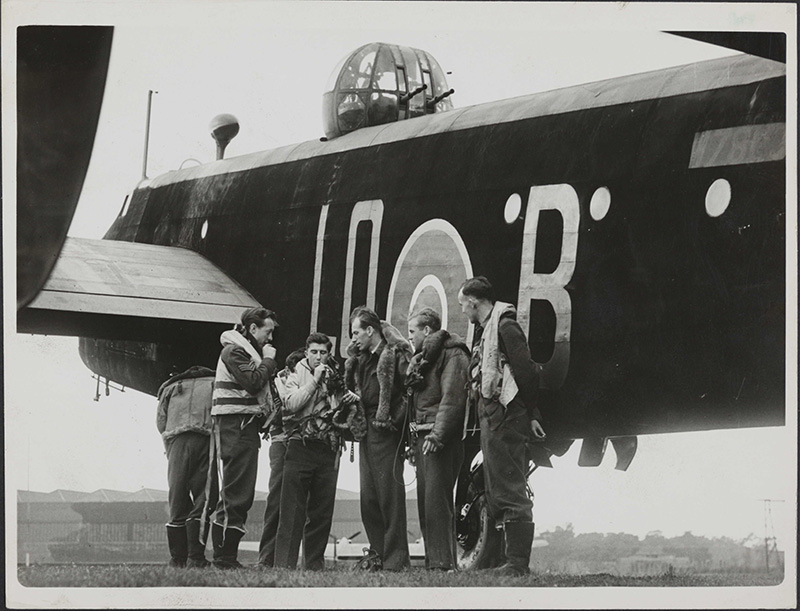Identifying R.A.F. Squadrons and units from pictures can be a tricky beast to get to grips with. Royal Air Force uniform, unlike the Army, did not carry unit insignia in the form of a cap badge or tactical recognition flash. Only modern R.A.F. flight suits carry any form of squadron insignia in the form of patches on the upper arm. Thus, even Forces War Records photo experts can be left scratching their heads when asked to identify R.A.F. units from pictures. However, one trick we have been utilising is Squadron Codes.
Squadron Codes are a set of alpha-numeric characters painted on the side of military aircraft to indicate the squadron the aircraft belonged to. These were normally 1 or 2 characters next to the large R.A.F. roundel on the side of the fuselage serving as the suffix or prefix of the aircraft’s identity. A single letter on the other side of the roundel indicated the name of the particular aircraft, ‘G for George’ for example. If squadrons were of a suitable size, multiple Squadron Codes could be used to represent them. No. 111 Squadron for example had ‘B’, ‘H’ and ‘JU’ during the Second World War. Commonwealth air forces with overlapping Squadron Numbers often carried their own unique Squadron Codes, for example No. 111 R.C.A.F. utilised ‘TM’ and ‘LZ’ during the war, to avoid confusion with the R.A.F.
It is not an infallible system however, Squadron Codes could be and often were repeated. ‘A’ for example was used 25 times for numerous different units. But don’t panic! Many R.A.F. units were temporary, forming one year and disbanding the next or were otherwise distinguishable. As with all genealogy start feeding in what else you know about the ancestor you are researching and you’ll be able to knock off many units from the list. If you still find there a few too many units, start picking out the equipment visible in the picture. It’s normally relatively easy to tell a fighter aircraft from a bomber which allows you to start distinguishing commands. If your ancestor is with a Spitfire then you know he was with Fighter Command and thus the bomber squadrons with the same Squadron Code you have can be eliminated. If you are really knowledgeable about aircraft you may also be able to identify a squadron by the type of aircraft being used. Once a new version of an aircraft was released there wasn’t an immediate replacement of all aircraft of the previous type across the whole air force. It was often squadron by squadron that the new aircraft were introduced. In addition, Commonwealth air forces, like the Royal Australian Air Force, used a lot of their own equipment, so instead of buying Spitfires from the UK, they built Commonwealth Aircraft Corporation (C.A.C.) Boomerangs. Other Commonwealth air forces continued to use equipment that had been phased out from the R.A.F. right up to the end of the war. The Bristol Beaufort and Bristol Blenheim bombers by 1942 were being replaced in R.A.F. service by newer upgraded models. But they could still be found in the thick of the action in 1945, in South African Air Force or Royal Australian Air Force colours.
If you are still unable to narrow down to a specific squadron it’s time to jump on the Forces War Records site for a bit of searching. Enter the name of the serviceman you are trying to identify and match up any results with the possible Squadron Numbers you have.
Our researcher recently took part in a live Q&A session in which a user was looking for details of a Lancaster Bomber that attacked the Normandy beaches on D-Day. Sadly the user had the wrong Squadron Number which was leading them nowhere, but as luck would have it there was a picture showing the Lancaster with the Squadron Code J*QB (* for R.A.F. Roundel). As per the layout of the codes this indicated it was Lancaster ‘J for Jig’ and that it was either, No. 550 Squadron R.A.F., No. 600 Squadron R.A.F. or No. 451 Squadron R.A.A.F. 600 and 451 squadrons were primarily equipped with fighters like the Spitfire and Hurricane, which eliminated them immediately leaving 550 Squadron which was from Bomber Command and equipped exclusively with Lancaster bombers. From that Tom was able to find both a crew list indicating the crew positions and a number of the missions the aircraft and crew had taken part in thanks to the R.A.F. Bomber Command Diaries by Martin Middlebrook and Chris Everitt.
Knowing the squadron of an R.A.F. serviceman is as useful as knowing the regiment and battalion of a soldier in the Army. With it you can view the Operational log books and combat reports produced by the R.A.F. during the Second World War to flesh out your ancestor’s service. It is also of significant help when filling out the appropriate forms to request Service Records from the Ministry of Defence.
A full database of R.A.F. Squadron Codes can be found on Wikipedia (en.wikipedia.org/wiki/List_of_RAF_squadron_codes). Be warned, this is a very long list owing to the vast number of units in service during the war, but it is organised alphabetically. Squadron Codes beginning with numbers follow those beginning with letters in the list.


